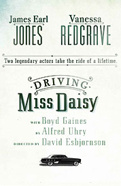How Alfred Uhry Turned Family Memories Into the Beloved Classic Driving Miss Daisy
About the author:
Fun trivia question: Name the only person to win an Oscar, a Tony and a Pulitzer Prize for dramatic writing. Answer? Alfred Uhry, author of the play and screenplay of Driving Miss Daisy. This loving and lovable story of an elderly Jewish matron in mid-century Atlanta who begrudgingly agrees to give up her car keys and allow herself to be chauffeured by an African-American driver became an instant hit at Playwrights Horizons in 1987. Two years later, the play was transformed into an Oscar-winning movie—but it took more than 20 years for Uhry to agree to bring Daisy to Broadway. The courtly playwright, also known as librettist of Parade, LoveMusik and The Robber Bridegroom and author of the Tony-winning comedy The Last Night of Ballyhoo, charted the history of his most famous creation for Broadway.com.
![]()
Twenty-five years ago, I wrote a play about my childhood in Atlanta, Georgia. Playwriting 101 tells you to write what you know, and that’s what I did. Two of the characters were composites of people in my family—my parents, my grandmother, my brother-in-law, my aunts, a few cousins and myself. The third character, Hoke Coleburn, was pretty much based on Will Coleman, my grandmother’s chauffeur. I wrote very specifically about time and place. All the events really happened, one way or another, though I moved things around a bit to serve my purposes. It was a family memoir, and I didn’t think it would have much appeal to anyone who wasn’t familiar with Atlanta in those days.
The play was scheduled to run off-Broadway for five weeks in a 74-seat theater on the far west side of Manhattan, two flights up on 42nd Street. In the cast were Dana Ivey, Morgan Freeman and Ray Gill. From the very first performance, the play seemed to have some sort of light around it. People loved it, and the run was extended to 10 weeks— then 20, and eventually three years. To my amazement, it won the Pulitzer Prize. It was made into a film, directed by Bruce Beresford and starring Jessica Tandy, Morgan Freeman and Dan Aykroyd. People loved that, too. It won the Academy Award for Best Picture of the Year and I won an Oscar for writing it. The whole experience was pretty unreal—as if it were happening to somebody else. I sort of floated along with everything, waiting for the bubble to burst, but it never did.
Driving Miss Daisy was performed all over the world. It had a familiar title, only three characters and a simple set. What’s not to like there? I’ve seen some fascinating photos of productions in South Africa, Romania, Japan, etc. I would’ve loved seeing some of those shows, but nobody ever asked me. However, they did ask me for permission to do the play on Broadway— many times over the ensuing years. I was approached with all sorts of odd casting ideas, none of which I will tell you about because I still try to be a southern gentleman. Nothing seemed exactly right to me and I wanted to protect my memory of that wonderful off-Broadway experience, so I said no (politely, I hope) over and over again.
Then Jed Bernstein came along. He didn’t come along, exactly. I’d known him and liked him for a long time. He was president of the Broadway League for 10 years, but he was ready to move on from that position and become a producer. He and his partner, Adam Zotovich, wanted to bring my play to Broadway. I’d heard that song before, but this time it began to make sense. We talked about the right director being essential to the project, and when David Esbjornson was suggested, I immediately said yes. I’d seen some of David’s work, especially his production of Edward Albee’s The Goat, or Who Is Sylvia?, and I admired his intelligent and unsentimental approach—just what I thought my play needed.
But who would play the parts? Again the lists. Some of them were the same names I had rejected before. I decided that we should only do the play if we could assemble a dream cast. Otherwise, what would be the point? So, who would be in that dream cast? How about James Earl Jones, Vanessa Redgrave and Boyd Gaines? Yeah, sure. That’s really gonna happen. But it did! Somehow or other, it did!
I’ve had the surreal experience of watching this production take shape. Many times I’ve been transported back to my childhood by the alchemy of these three actors. I have no idea how they do it, but each one manages to turn into those people I wrote about—the way they talk, the way they move, the facial expressions. Magic! And it happens over and over again right before my eyes!
So here Miss Daisy goes again—this time on Broadway, all flags flying. I couldn’t be happier.
Related Shows
Articles Trending Now
- Good Night, and Good Luck, Starring George Clooney, Opens on Broadway with Glitz and Glam But No Egos
- Adrienne Warren and Nick Jonas Open The Last Five Years, Jonathan Groff Dances as Bobby Darin and More on The Broadway Show
- All Aboard for Pirates! The Penzance Musical: The Swashbuckling Saga of Gilbert and Sullivan’s Comic Operetta
